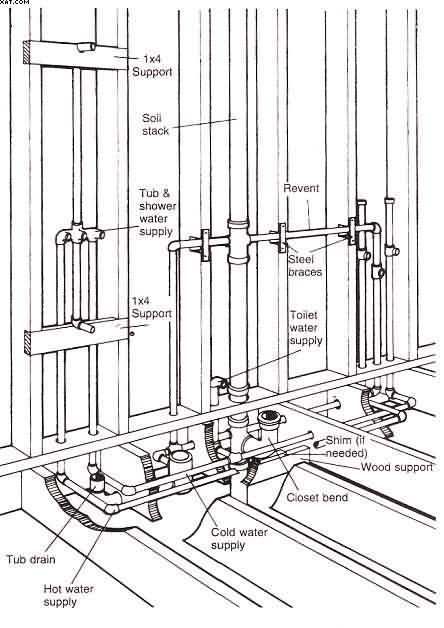When it comes to bathroom renovations or new constructions, understanding the plumbing layout is crucial. A proper bathroom plumbing diagram for rough in ensures that all the necessary pipes and fixtures are correctly installed, allowing for efficient water supply and drainage. In this article, we will explore the essential components and steps involved in creating a bathroom plumbing diagram for rough in.
A well-designed bathroom plumbing system ensures that water flows smoothly and waste is effectively disposed of. Before diving into the actual installation, it is essential to create a bathroom plumbing diagram for rough in. This diagram acts as a blueprint, guiding plumbers and contractors in the installation process.

Understanding the Basics of Bathroom Plumbing Diagram For Rough In
Before creating the plumbing diagram, it’s important to understand the basics of bathroom plumbing. The main components include water supply lines, drainage pipes, and venting pipes. The water supply lines provide clean water to fixtures like sinks, toilets, and showers, while the drainage pipes carry wastewater away. Venting pipes prevent airlock and ensure proper drainage flow.
Tools and Materials Required
To create a bathroom plumbing diagram, you’ll need a few essential tools and materials. These include graph paper or a digital design tool, a measuring tape, a level, a pencil, an eraser, and a ruler. Additionally, knowledge of plumbing codes and regulations in your area is vital to ensure compliance and safety.
Creating the Bathroom Plumbing Diagram For Rough In
Here’s a step-by-step guide to creating a bathroom plumbing diagram for rough in:
- Measure and mark the bathroom dimensions on the graph paper or digital design tool.
- Identify the locations of fixtures such as sinks, toilets, showers, and bathtubs.
- Plan the water supply lines, ensuring they connect to each fixture. Use different colors or line styles to differentiate hot and cold water lines.
- Determine the drainage paths, making sure each fixture has a corresponding drain pipe.
- Add venting pipes to the diagram, ensuring they connect to the drainage system.
- Double-check the layout for any potential issues or conflicts.
- Make adjustments as necessary to optimize the plumbing layout.
Water Supply System
The water supply system in a bathroom consists of pipes that deliver clean water to various fixtures. Each fixture requires a dedicated water supply line. The main supply line brings water into the bathroom, and individual branch lines connect to sinks, toilets, showers, and other fixtures. It is essential to ensure proper pipe sizing and maintain adequate water pressure throughout the system.
Drainage System Bathroom Plumbing Diagram For Rough In
The drainage system is responsible for carrying wastewater away from the bathroom fixtures. Each fixture has a drain pipe that connects to the main drain line. The drain pipes should be properly sloped to facilitate the flow of wastewater and prevent clogs. Traps are installed in drain lines to prevent sewer gas from entering the bathroom.
Venting System Bathroom Plumbing Diagram For Rough In
Venting pipes play a crucial role in the plumbing system by allowing air to enter and escape from drain lines. This prevents airlock and ensures smooth drainage flow. Vent pipes connect to the drain system and extend through the roof to release odors and gases outside. Proper venting also helps prevent siphoning of water from traps.
Finalizing the Plumbing Layout
Once you have created the initial plumbing diagram, it’s important to review and finalize the layout. Check for any potential conflicts or issues such as intersecting pipes or inadequate slopes. Make adjustments as needed to ensure optimal functionality and compliance with plumbing codes.
Tips for Effective Bathroom Plumbing
- Plan the layout carefully to optimize space and functionality.
- Use high-quality materials and fixtures to ensure durability.
- Consider future maintenance needs when designing the plumbing system.
- Consult a professional plumber if you’re unsure about any aspect of the installation.
Common Mistakes to Avoid
- Insufficient slope in drain pipes, leading to clogs and poor drainage.
- Improper pipe sizing, resulting in reduced water pressure.
- Lack of proper venting, causing sewer gas odors and slow drainage.
- Non-compliance with local plumbing codes and regulations.
Conclusion Bathroom Plumbing Diagram For Rough In
Designing an efficient bathroom plumbing system requires careful planning and attention to detail. Creating a bathroom plumbing diagram for rough in serves as a roadmap for the installation process, ensuring that water supply and drainage systems function properly. By following the steps outlined in this article, you’ll be well-equipped to tackle your bathroom plumbing project with confidence.
Bathroom Plumbing Diagram For Rough In Pictures
Bathroom Plumbing Diagram For Rough In
Rough Plumbing Height For Bathtub Shower
Kitchen Sink Plumbing Diagram
Clean Plumbing Tips For Bathroom Drains
Bathroom Plumbing Diagram For Rough In
Basement Bathroom Plumbing Rough In Diagram
Sample Kitchen Plumbing Diagram
Toilet Bathroom Plumbing Diagram For Rough In
Bathroom Plumbing Diagram For Rough In
Vent Bathroom Plumbing Drains
Shower Plumbing Rough In Dimensions
Small Bathroom Plumbing Basement
DIY Toilet Rough In Bathroom Plumbing
House Plumbing Diagram
Bathroom Plumbing Toilet Vent
Vent Bathroom Plumbing Drains
Bathroom Sink Rough In Diagram
Simple Shower Plumbing Diagram Intended For Bathroom
Bathroom Plumbing Diagram For Rough In



















